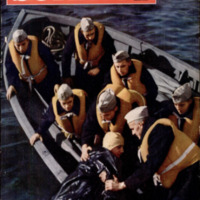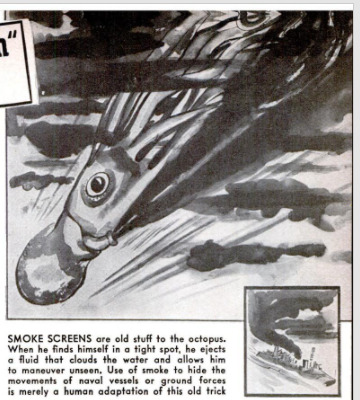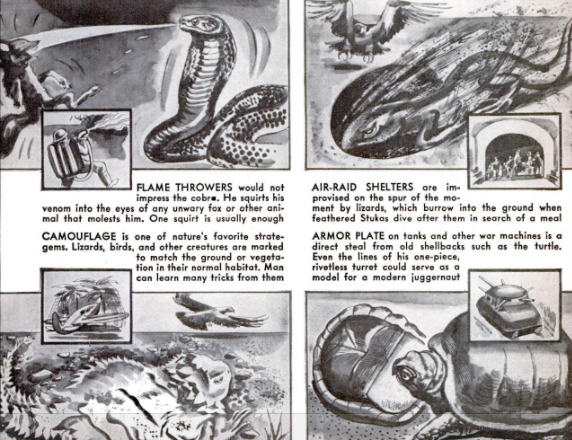Nature's "modern" war weapons
Item
-
Title (Dublin Core)
-
Nature's "modern" war weapons
-
Article Title and/or Image Caption (Dublin Core)
-
Title: Nature's "modern" war weapons
-
extracted text (Extract Text)
-
MOTHER NATURE was the first war
inventor. To protect her crea-
tures against their enemies, or
to help them hunt their prey, she
has provided them with weapons
and tactics that in many cases
anticipated the vaunted “new
weapons” of modern human war-
fare. The skunk was a past
master of chemical warfare long
before men ever thought of us-
ing gas to demoralize their ene-
mies; warring ants display or- |
ganization worthy of larger bel-
ligerents. In many weapons man
has consciously copied nature; |
in others he has arrived scien-
tifically at results she achieved |
through evolution. |
SMOKE SCREENS are old stuff to the octopus.
When he finds himself in a fight spot, he ejects
a fluid that clouds the water and allows him
to maneuver unseen. Use of smoke to hide the
movements of naval vessels or ground forces
is merely a human adaptation of this old trick
AIR-RAID SHELTERS are im-
provised on the spur of the mo-
ment by lizards, which burrow into the ground when
feathered Stukas dive after them in search of a meal
ARMOR PLATE on tanks and other war machines is a
direct steal from old shellbocks such as the turtle.
Even the lines of his one-piece,
rivetless turret could serve as o
model for a modern juggemot
FLAME THROWERS would not
impress the cobra. He squirts his
venom into the eyes of any unwary fox or other ani-
mal that molests him. One squirt is usually enough
CAMOUFLAGE is one of nature's favorite strate-
gems. Lizards, birds, and other creatures are marked
to match the ground or vegeta-
tion in their normal habitat. Man
can learn many tricks from them
-
Contributor (Dublin Core)
-
Gus Mager (Illustrator)
-
Language (Dublin Core)
-
eng
-
Date Issued (Dublin Core)
-
1943-03
-
pages (Bibliographic Ontology)
-
105
-
Rights (Dublin Core)
-
Public Domain (Google Digitized)
-
Archived by (Dublin Core)
-
Matteo Ridolfi
-
Marco Bortolami (editor)
 Popular Science Monthly, v. 142, n. 3, 1943
Popular Science Monthly, v. 142, n. 3, 1943




